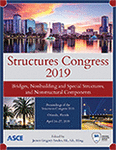Structures Congress 2019
Crack Sensor Using Commercial UHF RFID Technology for Metallic Structures
Publication: Structures Congress 2019: Bridges, Nonbuilding and Special Structures, and Nonstructural Components
ABSTRACT
Many in-service steel bridges rely on the successful load transfer between critical members at connections. These connections often have high stress concentrations that make a way for crack propagation, resulting in a reduction in load capacity. Thus, detecting cracks in the connections on a steel girder bridge in a timely manner is of paramount importance. To date, visual inspection has been the principal method for detection of cracks. Recently, monitoring methods using in-house radio frequency identification (RFID)-based crack sensors or other patch-type sensors have been developed to complement visual inspection with quantitative damage information. However, their application in the field is costly. On the other hand, commercial ultra-high frequency (UHF) passive RFID tags offer similar properties at a more viable cost. This paper presents a development of a new crack sensor for metallic structures using commercial passive RFID technology. This sensor uses backscatter power as the main damage identification parameter. A new method for crack propagation testing was designed to evaluate the performance of any backscatter power-based crack sensor to monitor propagating cracks on a metallic surface using plate specimens designed for standard fracture toughness testing. Crack and fracture mode characteristics were determined with high precision using digital image correlation and high-resolution photography. The development and performance evaluation of this commercial RFID-based crack sensor contributes to the advancement of this technology for steel girder bridge monitoring.
Get full access to this article
View all available purchase options and get full access to this chapter.
References
ASCE (American Society of Civil Engineers). (2017). “Bridges.” Infrastructure Report Card, <https://www.infrastructurereportcard.org/wp-content/uploads/2017/01/Bridges-Final.pdf> (Sep. 19, 2017).
ASTM International. (2012). Standard Test Method for Plane-Strain Fracture Toughness of Metallic Materials. ASTM E399-12e3, ASTM International, West Conshohocken, PA.
Blaber, J. (2013). “DIC Algorithms.” <http://ncorr.com/index.php/dic-algorithms#1_1> (Jul. 25, 2017).
FHWA (Federal Highway Administration). (2004). “National Bridge Inspection Standards 23 CFR Part 650.” Federal Register, Washington, D.C., 69(239), 74436–74439.
Haghani, R., Al-Emrani, M., and Heshmati, M. (2012). “Fatigue-Prone Details in Steel Bridges.” Buildings, 2, 456–476.
Impinj. (2018). “Speedway R420 Rain RFID Reader.” <https://www.impinj.com/platform/connectivity/speedway-r420/> (Jan. 29, 2018).
Kalansuriya, P., Bhattacharyya, R., and Sarma, S. (2013). “RFID tag antenna-based sensing for pervasive surface crack detection.” IEEE Sensors Journal, 13(5), 1564–1570.
Kim, Y. J., and Harries, K. A. (2011). “Fatigue behavior of damaged steel beams repaired with CFRP strips.” Engineering Structures, 33(5), 1491–1502.
Kwon, K., and Frangopol, D. M. (2010). “Bridge fatigue reliability assessment using probability density functions of equivalent stress range based on field monitoring data.” International Journal of Fatigue, 32(8), 1221–1232.
Martínez-Castro, R. E., Jang, S., Nicholas, J., and Bansal, R. (2017). “Experimental assessment of an RFID-based crack sensor for steel structures.” Smart Materials and Structures, 26(8), 85035.
Mohammad, I., and Huang, H. (2011). “An antenna sensor for crack detection and monitoring.” Advances in Structural Engineering, 14(1), 47–53.
Yi, X., Cho, C., Cooper, J., Wang, Y., Tentzeris, M. M., and Leon, R. T. (2013). “Passive wireless antenna sensor for strain and crack sensing—electromagnetic modeling, simulation, and testing.” Smart Materials and Structures, 22(8), 085009.
Zhang, J., Tian, G., Marindra, A., Sunny, A., and Zhao, A. (2017). “A Review of Passive RFID Tag Antenna-Based Sensors and Systems for Structural Health Monitoring Applications.” Sensors, 17(2), 265.
Information & Authors
Information
Published In
Structures Congress 2019: Bridges, Nonbuilding and Special Structures, and Nonstructural Components
Pages: 68 - 77
Editor: James Gregory Soules, McDermott International
ISBN (Online): 978-0-7844-8223-0
Copyright
© 2019 American Society of Civil Engineers.
History
Published online: Apr 22, 2019
Authors
Metrics & Citations
Metrics
Citations
Download citation
If you have the appropriate software installed, you can download article citation data to the citation manager of your choice. Simply select your manager software from the list below and click Download.
